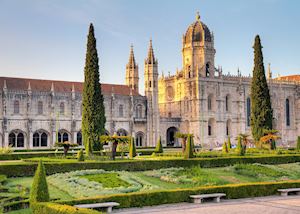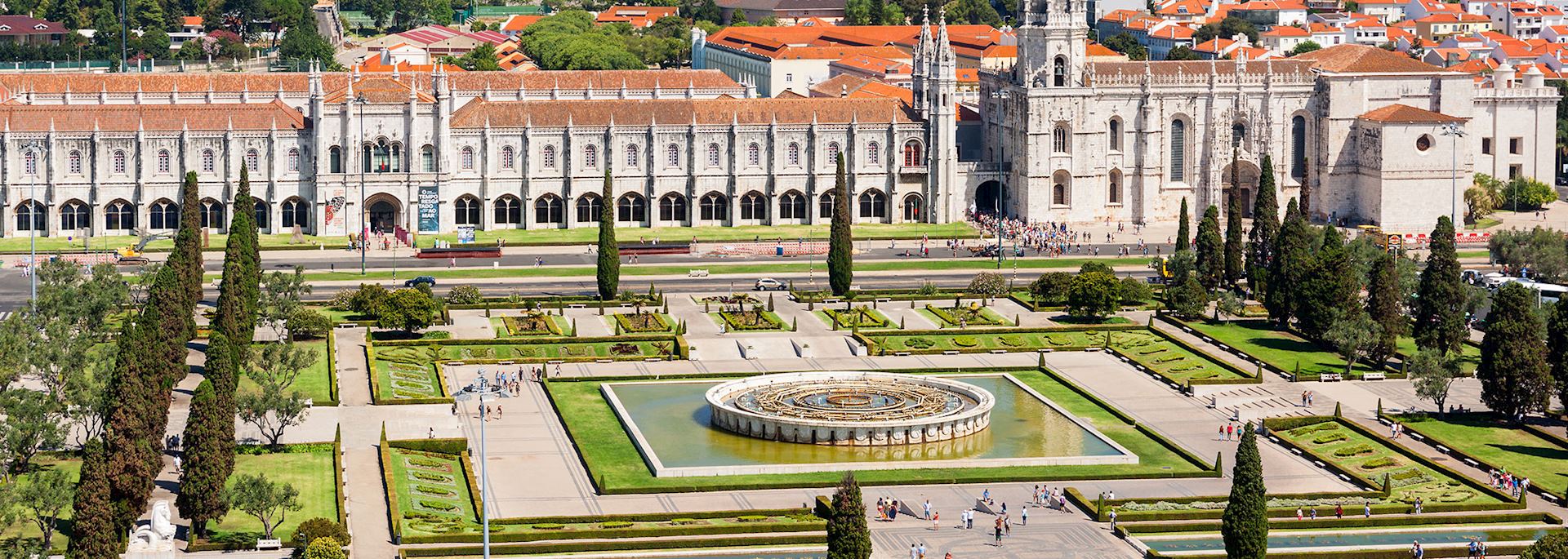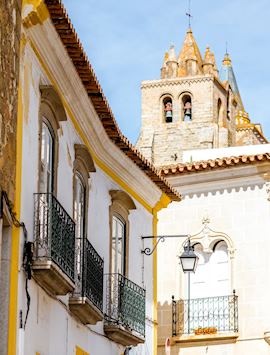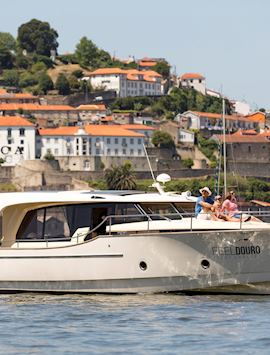Jump to:
Technically a parish of Lisbon, Belém was its own city until 2012 and is a destination in its own right. Many of Portugal’s explorers set sail from here and it’s where the Jerónimos Monastery was built to commemorate Vasco da Gama’s success. The monastery and the nearby Torre de Belém (Belém Tower), both UNESCO World Heritage Sites, are two of the finest examples of the Gothic-inspired, maritime-themed style known as Manueline.
Belém is also home to several good museums and gardens, as well as the Pastéis de Belém, a café known for making Lisbon’s signature custard tarts for almost two centuries.
Spain & Portugal specialist GeoffThe sense of history in Belém is palpable. Formerly a tiny port and fishing village on the edge of Lisbon, it has been transformed into a monumental landscape celebrating the fortune-changing voyages of discovery that all began here.
Things to see and do in Belém
Jerónimos Monastery
Many of Portugal’s 15th-century explorers set sail from Belém, and before going to sea, they prayed for success at a small church there. They went on to discover sea routes that helped Portugal establish a profitable trade in African slaves and Asian spices.
 Flush with this new wealth, King Manuel I celebrated with several new building projects, including replacing the small church with something much grander. The Jerónimos Monastery — built to celebrate Da Gama’s 1499 voyage to India — featured a grandiose Gothic architecture that incorporated nautical themes. Eventually, the style would be known as Manueline.
Flush with this new wealth, King Manuel I celebrated with several new building projects, including replacing the small church with something much grander. The Jerónimos Monastery — built to celebrate Da Gama’s 1499 voyage to India — featured a grandiose Gothic architecture that incorporated nautical themes. Eventually, the style would be known as Manueline.
It’s a gloriously overwrought masterpiece that fairly froths with ornamentation. The cloisters alone are a tumult of waves and shells and rope knots and armillary spheres, all rendered in precise detail from honey-toned stone.
Da Gama himself is interred here, alongside Luís de Camões, who is widely regarded as Portugal’s greatest poet.
Torre de Belém (Belém Tower)
Just a short walk from the Jerónimos Monastery, the Torre de Belém looks like a rook from a particularly ostentatious chess set. This fortress on the Tagus River is a fantasy in limestone filigree, with lacy cupolas, an abundance of crenulations and a very weathered stone rhinoceros.
The lines to get inside in summer can get very long and the interior is rather cramped. We find the view from the exterior to be just as rewarding.
Padrão dos Descobrimentos
This monument to Portugal’s many explorers looks like the prow of a caravel about to set sail. Standing at the bow is Prince Henry the Navigator — known locally as Infante Dom Henrique, o Navegador. Arrayed behind him are 33 statues celebrating the people who contributed to the country’s many discoveries, including Cabral, Magellan and Da Gama.
It’s set in a plaza featuring a stone mosaic of a compass rose and a map of the world that charts the various voyages of Portugal’s explorers. Designed in 1939, the monument was inaugurated in 1960, on the 500th anniversary of Prince Henry’s death. You can take the elevator up to the top (or hike up nearly 300 steps) for a panorama of the river.
Pastéis de Belém
Custard tarts known as pastéis de nata are one of the signature dishes of Lisbon and Belém, a physical embodiment of the country’s history. After the Liberal Revolution of 1820, the monks at the Jerónimos Monastery began selling the sweet eggy tarts at a nearby sugar refinery in an effort to survive. When the monastery closed, the refinery bought the recipe and, in 1837, opened Pastéis de Belém.
The café — marked by blue-and-white awnings — is owned by the descendants of the refinery, and the tarts are still made according to the original methods. Even today, bakers at Pastéis de Belém must sign a pledge never to reveal the monks’ secret recipe.
The small pastries are made from flaky, buttery pastry, puffed up into delicate layers, and a rich, eggy custard that’s blistered brown on top, adding hints of caramel and butterscotch. They taste best eaten warm, with a shot of espresso and, if you like, a small sprinkling of cinnamon.
Museu de Marinha (Maritime Museum)
Housed in the west wing of the monastery, the Museu de Marinha celebrates the glory and opulence of the era when Portugal dominated the high seas. Ships and ship models gleam with gilt curlicues and dragon figureheads roar with golden maws.
The museum features ships from the 15th to 20th centuries, including models of caravels, the revolutionary style of ship that permitted Portuguese sailors to venture far from shore. (The caravel’s lateen sails allowed windward sailing, an innovation developed under the patronage of Prince Henry the Navigator.) You’ll also find royal barges, modern warships, cannonballs and historic globes that don’t include Australia.
Museu Coleção Berardo
The severe, blocky exterior of this gallery hints at the eye-popping display of modern and contemporary art inside. Inaugurated in 2007, its permanent exhibit is based on the personal collection of Portuguese millionaire José Berardo. Many of the superstar artists of the 20th century are represented, including Picasso, Dalí, Hockney, Lichtenstein, Warhol and Pollock.
The minimalist gallery is spacious with blindingly white walls, the better to showcase the oversaturated prints of Warhol or the delicate kinetic sculptures of Calder. Ever-changing temporary exhibits spotlight artists and works from around the world.
Museu Nacional dos Coches (National Coach Museum)
One of Portugal’s most-visited museums illustrates the country’s rich past with displays of Cinderella-worthy coaches from the 16th to 19th centuries. These conveyances drip with gilt and highlight the extravagant tastes of the royal family, though you’ll also find examples from other European countries.
The grandiose Coach of the Oceans, a papal embassy coach, dates to 1716. This outrageous jewel box of a carriage features a tableau of five life-sized classical statues, entirely covered in gold leaf, riding pillion.
The collection is housed in an ultramodern building that’s at odds with the historic displays. Across the street is the royal riding school, Antigo Picadeiro Real. It displays a few select examples of carriages within majestic halls featuring 18th-century frescoes, enormous oil paintings and an elevated arcade.
Best time to visit Belém
The weather in Belém can get hot in the summer months (June to August), so we suggest visiting in March to May or September and October.
who's been there
- 617-223-4772
- Make an inquiry
Suggested itineraries featuring µþ±ð±ôé³¾
Our itineraries will give you suggestions for what is possible when you travel in µþ±ð±ôé³¾, and they showcase routes we know work particularly well. Treat them as inspiration, because your trip will be created uniquely by one of our specialists.
Places near µþ±ð±ôé³¾
- Lisbon 8 kilometers away
- Estremadura 9 kilometers away
- Sintra 20 kilometers away
- Évora & the Alentejo 115 kilometers away
- Coimbra 182 kilometers away
- Algarve 218 kilometers away
- Porto 279 kilometers away
- Douro Valley 299 kilometers away
- Braga and Guimarães 325 kilometers away



